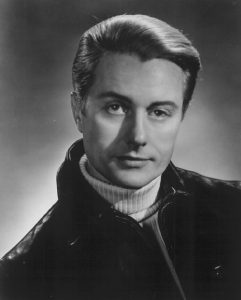Lavern Cummings, The Sophisticate of Song
 Four Decades of Excellence and Elegance
Four Decades of Excellence and Elegance
By Ken Spaulding
Note: Click on images to see the full scale version.
Though the practice goes back some 4,000 years, here in America, Female Impersonation has been around as a “popular” form of entertainment since the late 1880s. One of the most famous and talented performers of all-time was the “Sophisticate of Song.”…Lavern Cummings.
For over 30 years, Lavern Cummings practiced the Art of Female Illusion at the “highest level.” Six years with the renowned Jewel Box Review, and over 25 years at the world famous Finocchio Club in San Francisco.
A brilliant songstress with a vast repertoire, the always elegant Lavern would sing in a sensational voice to match her glamour and beauty. Night after night Lavern Cummings entertained, amazed, and delighted audiences comprised of people from all over the world.
“And now… let’s bring to the stage, the form and grace, and lovely face of our Sophisticate of Song… the incomparable Mr. Lavern Cummings!”
KS: With the vast number of multi-media outlets available today, FI is pretty well known compared to “days gone by.” What back then exposed you, and then triggered your entrance into a career of FI?
LC: I was probably exposed to female impersonation while I was still in my late teens or early twenties. I had gone to Long Beach, CA with some friends of mine to see my first drag show. Later on we went to Los Angeles to see some shows at different clubs. The Flamingo Club was going then, along with the Club Continental.
KS: So what was your first professional engagement?
LC: My first professional engagement was at the Club Continental. Actually it was called Tess’s Club Continental. It was a mix of lesbians and gays. I had gone there with some friends one evening when they were having an amateur contest. My friends encouraged me to get up and sing, as they knew that I sang in the high register. I did and was then offered a job. I came in first in the amateur contest, much to my surprise.
KS: Was there anyone who helped you learn the craft as you were first starting out?
LC: Actually, there were a couple of people who helped me with certain things…how to dress and be as graceful as possible. I had seen a couple of the other shows where I would study the other people to see how they would perform. You learn what you can and then go out and do it with your own style.
KS: In the past it has been written that you “amazed audiences with your clear soprano tones and unique split-voice song style. Please describe that characterization of your on-stage presentation.
LC: On stage I was very real. I had the high soprano voice, and I even wore my own hair at that time. I really didn’t start the split-voice until later on in my career, singing in female voice, then the male voice.
KS: Some people never attain a decent singing voice. How did you get not one…but two top quality singing voices? (male/female)
LC: I was a “boy-soprano”, and they also called it a falsetto voice. I sang in that voice until I went to high school, and they moved me into the tenor section of the choir. Then and there I knew I had both voices.
KS: What were some of the “best” cities and venues to play, and what were some of the “worst”?
KS: Your first “big break” was when you signed on with the Jewel Box Revue. How did that opportunity come about?
LC: I was working at the Club Continental after I had won the “amateur contest.” One night someone came into the club that was representing the Jewel Box Revue and asked me if I would like to join the show that was back east. I had only been at the Continental a few months, but after thinking about it, I decided to give it a shot. I was then sent transportation. In those day we usually traveled by bus. I then joined the show in Minneapolis, MN.
KS: As a new member of the JBR cast, was it smooth sailing at first or a tough row?
LC: Just about everyone was very nice to me when I joined Jewel Box Revue. The show had been running in Minneapolis all summer, changing the cast periodically, and I was one of the new additions.
KS: The JBR was a traveling show. Can you tell us a little about the ups and downs of the constant travel, and did it ever affect your performance?
LC: The travel didn’t affect the performance. We were always learning something new. With the Jewel Box we had big production numbers… three production numbers. We had the opening, a middle production, and the finale.
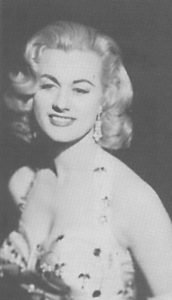 KS: What were some of the “best” cities and venues to play, and what were some of the “worst”?
KS: What were some of the “best” cities and venues to play, and what were some of the “worst”?
LC: It would depend… we were usually only booked for one week at a time, and we would be held over as a rule. One of my favorite cities was Columbus, Ohio of all places. After my first season in Miami, we went to Pittsburgh, PA which was also a good spot! The worst… I think it was in upstate New York… Albany, New York where we didn’t get too warm of a reception. This was in the early ‘50s and “drag” was not that popular. Yeah…I believe we kind of had a rough time in that spot.
KS: Was JBR a solid production technically speaking?
LC: The Jewel Box was very professional. With the productions we rehearsed a lot, as the clubs we went to had different size stages and the productions would have to be revamped to accommodate those differences. We also carried spotlights, wardrobe of course, so there was a truck that carried all of these things when we were on the road.
KS: What kind of “artistic freedom” did you have when it came to your song repertoire?
LC: We would pretty much have our own choice of songs and music. We would pick something, rehearse it and have it arranged of course. Sometimes songs were suggested to us by the show’s producers Danny Brown and Doc Benner.
KS: Since there were no karaoke machines back then, and you were singing “live,” what kind of musical support did the JBR provide?
LC: We had big orchestras in those days with eight, ten, twelve pieces and up! This made for a very full and professional sound.
KS: How much time was the Jewel Box Revue on the road each year?
LC: We were on the road six… seven… eight months sometimes depending on the booking and how long we were held over. We would play several spots some seasons and some seasons we would just play one or two, then back to Florida for the winter.
KS: As you made your way across America, how receptive were the different audiences, and was there any particular place that was notorious for being a “tough crowd?”
LC: As a rule the audiences were very receptive. They were appreciative. As one of the write-up’s said about us, “the girls are perfect gentleman.”
KS: Many of the greatest FIs’ of all-time were in the Jewel Box Revue. Besides yourself, who else was a cast member while you were there that could be considered an “all-time great” in the profession of FI?
LC: The big stars when I first joined the Jewel Box Revue were Leon LeVerde, T.C. Jones, Jackie Maye and “Miss Tommy Williams.” The show was billed “..25 Men and a Girl…” Miss Tommy Williams was the first “male impersonator” I worked with, however there were others in different seasons, Miss Micky Mercer, Miss Jo Vaughn and Miss Storme DeLarverie.
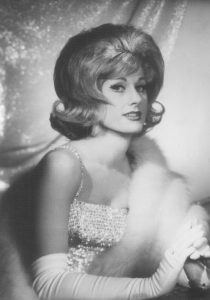 KS: The founders of JBR were Danny Brown and Doc Benner. How were they to work for?
KS: The founders of JBR were Danny Brown and Doc Benner. How were they to work for?
LC: Danny and Doc were very nice to work for. They made sure that the show was run properly. They would check the production numbers from out front many times to see that everybody was doing their routine. The show was run very tight.
KS: From the pictures I’ve seen, the JBR cast was fairly large. With that many FIs’ was it fierce competition for salary/solo spots and recognition, or was it a “team” situation where everyone knew their role?
LC: The size of the Jewel Box would vary from time to time. I believe when I joined the show in Minneapolis for the first time the cast was about 10 or 12. When I went to Miami that first season, the cast was 25 or more. It was pretty much a team situation. Everybody did their spot and the production numbers. We all worked the productions, unless you were early in the line-up of the show, then you didn’t work an opening perhaps, but we all worked productions. I was working as a showgirl in most of the productions at that time, mainly the middle production number and the finale.
KS: As you look back on your days with JBR, what stands out as the best part of that experience?
LC: My experience with the Jewel Box was very rewarding. I learned from the pros. I was working on my act then, building it, learning new songs all the time, trying to improve, sometimes with suggestions from Danny or Doc.
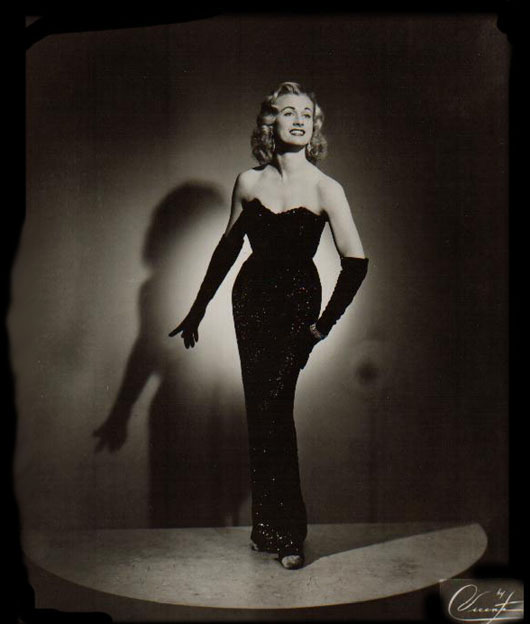 KS: Now we are to the year 1956. What were the major factors that made you decide to transition from the Jewel Box Review to Finocchio’s in San Francisco?
KS: Now we are to the year 1956. What were the major factors that made you decide to transition from the Jewel Box Review to Finocchio’s in San Francisco?
LC: Well of course the prestige of the Finocchio Club, the allure of San Francisco, plus I was getting a little weary of the constant touring. I stayed with the Jewel Box for about six years. The call came when we were working in upstate New York again, this time Niagara Falls, and I had this opportunity to open at Finocchio’s.
KS: They say “performing is the name of the game,” but did being in a new city and a new club make it difficult for you at first?
LC: I opened at Finocchio’s along with Kara Montez in October of 1956. I was a little nervous since it was “new” and a different set-up from the Jewel Box… but things worked out ok.
KS: The Finocchio Club was and still is located at 506 Broadway. [Editor’s Note: The club closed November 27, 1999.] Was the whole scene on Broadway really that “electrifying” back in the ’50s and ’60s? You always hear things like,” …oh Broadway is not as good as it used to be, we need to revitalize Broadway.”
LC: After opening at Finocchio’s and getting settled, business seemed to start picking up in the late ’50s on Broadway. Later on we had the Gray Line Tours bringing people to Finocchio’s and “Broadway” a couple of times a night.
KS: The 1960s was a turbulent time with some evolution on the political and cultural scene of America. By the late ’60s San Francisco was getting more than its share of the “national spotlight.” On reflection, did this cause an increase in tourists visiting the club and was there a change in the audiences during this period?LC: After opening at Finocchio’s and getting settled, business seemed to start picking up in the late ’50s on Broadway. Later on we had the Gray Line Tours bringing people to Finocchio’s and “Broadway” a couple of times a night.
LC: Yes, in the ’60s business picked up a lot. We used to get many celebrities up from Hollywood. We would get people from all over the world, the audiences became more “international.” The audiences often had people from Japan and Germany. One night the dancers from the Russian Ballet came to see the show, just as so many of the entertainers did when they were in San Francisco for a performing engagement.
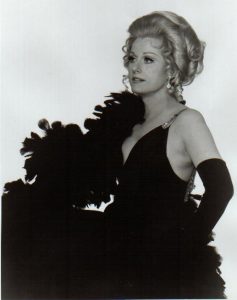
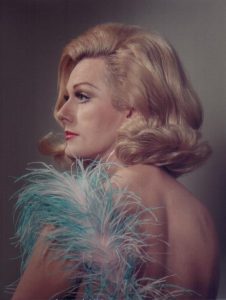 KS: There were a lot of changes on the “music scene” during the 1960s. Was it a challenge for you and the club to be “contemporary” during those changing times?
KS: There were a lot of changes on the “music scene” during the 1960s. Was it a challenge for you and the club to be “contemporary” during those changing times?
LC: At the time, Finocchio’s presented an “old-fashioned” show. We were doing show tunes… Broadway show tunes and some popular things of the day… no Rock and Roll, we were limited there because we only had a trio to work with.
KS: At Finocchio’s you also worked with a “live” band. Were they a cohesive unit, or were there constant personnel changes that created a “challenging situation” for you as a vocalist?
LC: That was the let down for me at Finocchio’s. We only had piano, drums, and saxophone. It was a challenge for me as a vocalist because I had all of these big arrangements, so I had to have everything revamped to fit the trio, and all of that worked out eventually.
KS: At Finocchio’s, how much control did they exert over the content of the show, and did they give you a free hand when it came to your material?
LC: Finocchio’s had control of the production numbers more or less. The MC at the time when I first opened was Lestre LaMonte. He also choreographed the show finale’s in which we would all have to appear. For the most part I had a free hand in selecting my own material, which was limited to two songs per show.
KS: Was there ever any time to mingle with the audiences between shows?
LC: When I first opened we were allowed to mingle. We would come out for a soft drink between shows, and people would come up and congratulate us on the show. Later on we were not allowed to mingle at all! That started in the late ’50s or early ’60s.
KS: What makeup did you like for the stage?
LC: I did not wear too heavy of a makeup at this time since I was still in my 20s. I did wear false eyelashes, liner, lipstick and a nice Max Factor pancake, because the lighting was not so great at Finocchio’s.
KS: Were the gowns you had designed for you or did you buy them “off the rack?”
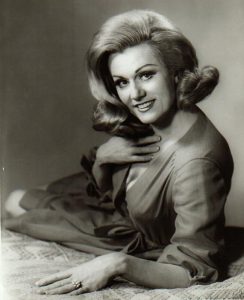 LC: I had come to Finocchio’s with some wardrobe that had already been designed for me by Tony Midnite. When I first started, I didn’t know anyone who could make things for me, so I did buy a couple gowns off the rack at I. Magnin’s. Later on I did find a designer, Mr. Talven, who created some marvelous things. The creations were very classy, and they helped to make an elegant “Lavern.”
LC: I had come to Finocchio’s with some wardrobe that had already been designed for me by Tony Midnite. When I first started, I didn’t know anyone who could make things for me, so I did buy a couple gowns off the rack at I. Magnin’s. Later on I did find a designer, Mr. Talven, who created some marvelous things. The creations were very classy, and they helped to make an elegant “Lavern.”
KS: Earlier you touched on the fact that you wore your own hair. When did you decide to wear wigs, and how did you get them to look so natural?
LC: I had a great stylist, Mr Franklin, who did some fabulous styles for me with my own hair, and then with the wigs after I cut my shoulder length hair in 1962. When I switched to wigs, I would use my own hair-line on the front and the sides to blend in the hair. A lot of people never knew the difference… it looked very natural.
KS: Did you have any special female stars from the stage/screen or music that influenced your presentation?
LC: Yes, I was influenced by screen stars and a few impersonators that I had seen previous to my going into drag. The screen stars were mainly from 1940s musicals: Deanna Durbin, Betty Grable, Alice Faye. Other influences were Marlene Dietrich, Doris Day, Rita Hayworth, who came to see us at Finocchio’s in 1957, and Arlene Dahl.
KS: Finocchio’s was pretty good about keeping the shows fresh because during the ‘60s and ’70s there was a whole lot of “repeat business.” Can you walk us through the process of what had to be done when you would add a new song?
LC: We could change our songs as often as we’d like. I wanted to build my repertoire, so I would change them quite often, as I was able to get the song arrangements to fit the trio. My repertoire got to the point where I could go an entire month without repeating a song.
KS: In 1979 you were in a Television Movie called The Golden Gate Murders. How did that come about for you?
LC: They were looking for a female impersonator. A talent scout/agent from Universal Studios was in the audience one night. After the show he made me an offer to test for this part, to see if I would like to do it.
 KS: Was your scene filmed on location at Finocchio’s, and how long did it take to film your segment?
KS: Was your scene filmed on location at Finocchio’s, and how long did it take to film your segment?
LC: No, my scene was filmed at Universal Studios and on location at a club called the Queen Mary in Hollywood. The filming didn’t take that long at all.
KS: Have you been in any other films?
LC: I tested for several films back in the ’60s including Myra Breckinridge and Gunn. I’ve also done television shows and interview programs where on occasion I would perform. Actually, after I left Finocchio’s, I did some work as an “extra” in various film productions around the Bay Area. I was in The Right Stuff, and Monster In The Closet.
KS: Now we are to the year 1982. You decide to retire from show biz. Without getting too personal, can you tell us why?
LC: I was doing a television show in late November, 1982 for KGO-TV, and my throat had started to tighten up. Right after that I had an asthma attack which affected my voice. I worked at Finocchio’s until the early part of December (1982) and I was still having the problem with my voice, so I had to… leave. Finocchio’s wanted me to come back. I was going to doctors at the time… I never did go back.
KS: Was it hard to give up performing?
LC: Yes, it was hard giving up performing because I missed singing. I took off for a year, didn’t do anything, then in 1984 I went to work in retail.
KS: Has Finocchio’s or any other club ever tried to lure you out of retirement?
LC: Yes, Finocchio’s wanted me to return, of course they kept on trying… but the singing voice was just not there anymore.
KS: Now that you are enjoying retirement, are you doing any special projects?
LC: I am enjoying my retirement, after working in retail at The Emporium from 1984 – 1996. In 1996, The Emporium was closed down, so I decided to move to Las Vegas! Right now I am in the process of writing my memoirs Its coming along. At present I am doing a lot of research on some things I had forgotten about.
KS: Can you give us an idea of when your book will be available?
LC: I have no idea right now when the book will be available. Hopefully during this next year, that’s what I’m working toward.
KS: As you look back on your fabulous career, at what point in time were you at your “absolute best” as a performer?
LC: I did enjoy working at the Jewel Box, but I was more polished when I got to Finocchio’s. Probably my “best time” there was in the late ’60s into the ’70s.
Truly a “performers’ performer,” Lavern Cummings attained a prestige that only a handful of other entertainers have ever achieved. Through constant hard work and dedication that the audience’s never even realized, Lavern set a performance standard in the Art of Female Illusion that levitates near the stratosphere.
© 1999 Ken Spaulding
Moved to make a comment? Login here and use the comment area below.
Category: History, Impersonation



